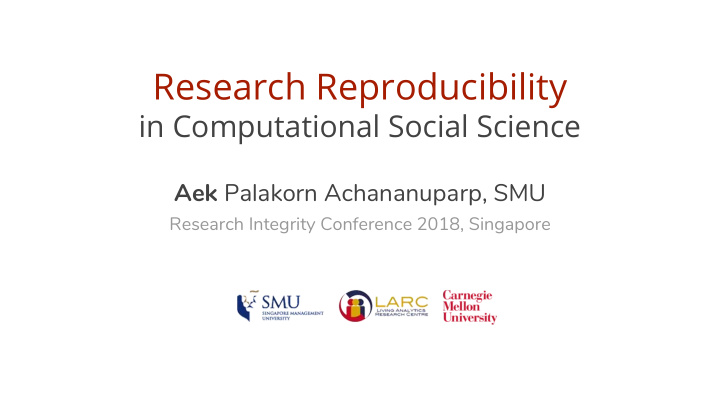



Research Reproducibility in Computational Social Science Aek Palakorn Achananuparp, SMU Research Integrity Conference 2018, Singapore
INTRODUCTION & DEFINITIONS
First coined by Lazer et al. (2009) in the Nature article COMPUTATIONAL SOCIAL SCIENCE Modeling human activity, behavior, and relationships through the use of (CSS) computational methods and large-scale data ( thousands to billions of data points) Image source: Designed by Itakod / Freepik
DATA SOURCES COMMON STUDY TOPICS “DIGITAL TRACES” Predicting friendships in social networks ● Modeling information diffusion process ● Predicting electoral outcomes ● Modeling human activity in offline settings ● Recommending books, papers, articles, ● movies, songs, etc.
WHAT DOES REPRODUCIBILITY MEAN? CONCEPT TEAM EXPERIMENT SETUP Repeatability Same Same Replicability Different Same Reproducibility Different Different Source: ACM
NON-COMPUTATIONAL V.S. COMPUTATIONAL RESEARCH In non-computational research: In computational research: Replicability = reproducibility Replicability = different groups can = different groups can obtain the obtain the same result using the same result independently by original study's artifacts (datasets, following the original study’s code, and workflows). methodology. Reproducibility = different groups can obtain the same result using independently developed artifacts.
COMPUTATIONAL REPRODUCIBILITY We’ll mostly focus on replication and reproduction of computational research, i.e., computational reproducibility, in CSS.
REPRODUCIBILITY CRISIS IN CSS?
REPRODUCIBILITY CRISIS IN CSS For electoral prediction studies using Twitter data, an independent group was not ● able to reproduce their positive results (Gayo-Avello et al. 2011). 61% of 21 social science studies published in Nature and Science can be reproduced ● (Camerer et al. 2018). For 54% of 601 studies published at major computational research conferences, an ● independent group was able to build the code or the authors stated the code would build with some effort (Collberg et al. 2014). Out of 400 artificial intelligence papers, 6% provide code for the papers’ algorithm, ● 30% provide test data, 54% provide pseudocode (Hutson, 2018).
REPRODUCIBILITY CHALLENGES IN CSS
TECHNOLOGICAL IRREPRODUCIBILITY Some code and dataset require high-performance or esoteric ● systems to run. Different tools, platforms, & versions may produce different results. ● Some software dependencies are no longer available. ● Is it still possible to run the original artifacts a few years later? ●
DATA PRIVACY & LEGAL LIMITATIONS Data privacy is going to be more critical than before after the ● Cambridge Analytica fiasco. More difficulty in collecting and sharing online social media data. ● Data ownership is not always clear-cut. ● Intellectual property prevents code sharing. ●
EXPERIMENTAL IRREPRODUCIBILITY Complex social systems are extremely difficult to study. ● States of the world are irrevocably not the same today compared to ● the time when the original experiments were conducted. Some external influences, e.g., media exposure, are almost ● impossible to control.
ENABLING REPRODUCIBLE RESEARCH
ENABLING REPRODUCIBLE RESEARCH Open Research/Data Platforms Open Science Framework ● CodaLab ● ReScience ● Jupyter Notebooks ●
ENABLING REPRODUCIBLE RESEARCH Open Data Repositories Microsoft Research Open Data ● Stanford Network Analysis Project ● (SNAP) UCI Machine Learning Repository ● GroupLens ● LARC Data Repository ●
LARC Data Repository
SAGAN STANDARD, UPDATED “Extraordinary claims require extraordinary evidence and extraordinary transparency.” Aek Palakorn Achananuparp palakorna@smu.edu.sg @aekpalakorn
REFERENCES Artifact Review and Badging, ACM. https://www.acm.org/publications/policies/artifact-review-badging. ● Butler, D. (2013) When Google got flu wrong. Nature ● Camerer et al. (2018) Evaluating the replicability of social science experiments in Nature and Science between ● 2010 and 2015. Nature Human Behavior 2. Collberg et al. (2014) Measuring Reproducibility in Computer Systems Research. University of Arizona Technical ● Report 14-04. Gayo-Avello et al. (2011) Limits of Electoral Predictions Using Twitter. In Proc. of ICWSM ‘11. ● Goodman et al. (2016) What does research reproducibility mean? Science Translational Medicine. ● Hutson, M. (2018) Missing data hinder replication of artificial intelligence studies. Science. ● http://www.sciencemag.org/news/2018/02/missing-data-hinder-replication-artificial-intelligence-studies Lazer et al. (2014) The Parable of Google Flu: Traps in Big Data Analysis. Science. ● Pentland, A. (2012) Big Data’s Biggest Obstacles. Harvard Business Review. ● Reproducibility in Machine Learning Workshop, ICML ‘18. ● https://sites.google.com/view/icml-reproducibility-workshop/home Stodden, V. (2013) Resolving Irreproducibility in Empirical and Computational Research. IMS Bulletin Online. ● Stodden et al. (2016) Enhancing reproducibility for computational methods. Science, 354(6317). ●
Recommend
More recommend